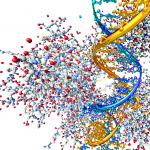 It has been two decades since researchers were able to identify two genes, BRCA1 and then BRCA2. These so-called “breast cancer genes,” when inherited with a faulty copy, would confer very high risks of breast and also ovarian cancers. The thinking was that with time, and as modern genetic tools evolved, researchers would find other genes equally as powerful in causing these and other cancers. Knowing one’s genetic risk might help decide who might need frequent mammograms or MRI’s and who might be able to safely forgo such testing or conversely benefit from preventative measures. Since the discovery of BRCA1 and BRCA2, a few additional high risk breast cancer genes have been discovered such as PALB2, LKB1, and CDH1; but these are very rare. Unfortunately, mother nature has not cooperated with science, and a BRCA3 or BRCA4 has yet to be discovered and may not exist. Instead of a handful of genes that confer great risk, it increasingly looks as if our genetic risk for cancer may be the sum total of hundreds of genes, some of which slightly increase risk, and some of which slightly lower risk.
It has been two decades since researchers were able to identify two genes, BRCA1 and then BRCA2. These so-called “breast cancer genes,” when inherited with a faulty copy, would confer very high risks of breast and also ovarian cancers. The thinking was that with time, and as modern genetic tools evolved, researchers would find other genes equally as powerful in causing these and other cancers. Knowing one’s genetic risk might help decide who might need frequent mammograms or MRI’s and who might be able to safely forgo such testing or conversely benefit from preventative measures. Since the discovery of BRCA1 and BRCA2, a few additional high risk breast cancer genes have been discovered such as PALB2, LKB1, and CDH1; but these are very rare. Unfortunately, mother nature has not cooperated with science, and a BRCA3 or BRCA4 has yet to be discovered and may not exist. Instead of a handful of genes that confer great risk, it increasingly looks as if our genetic risk for cancer may be the sum total of hundreds of genes, some of which slightly increase risk, and some of which slightly lower risk.
Though panels of multiple genes to predict one’s risk are being developed and a few are already commercially available, each of us has over twenty thousand genes and over a million genetic variations are known to occur. So an individual’s risk of developing cancer will likely be a complex and nuanced interplay of subtle genetic variations inherited from one’s mom and dad, which will take a long time to fully understand.
While the scientists are struggling with unraveling our genetic predispositions to cancer, lifestyle issues such as exercise, weight, and alcohol use are increasingly being recognized as contributing as much or more to cancer risk and over which we as individuals have some control. Next week – how interested is the public in reducing cancer risk through lifestyle changes? – Stay tuned for the surprising answer.
